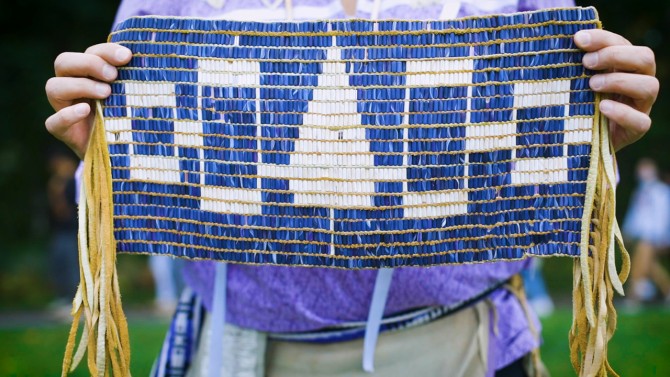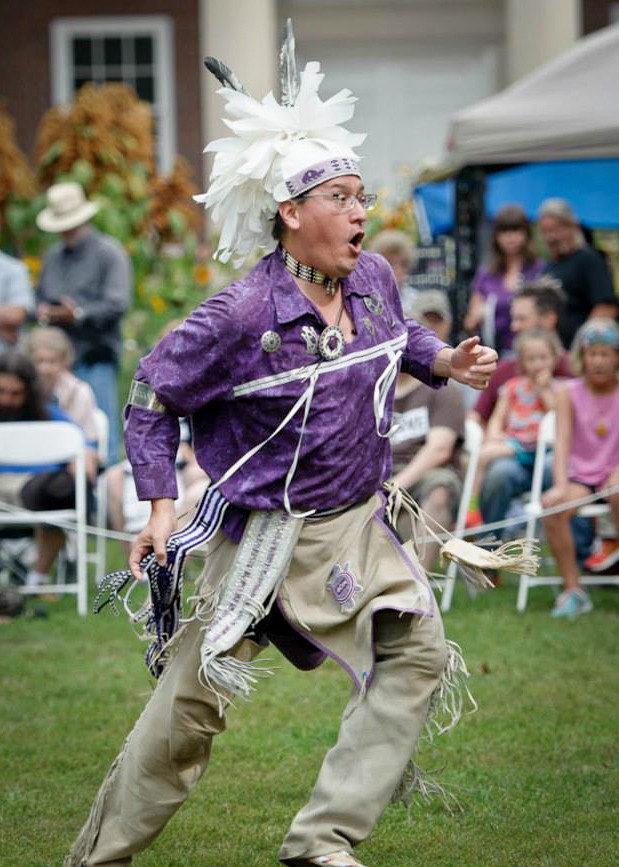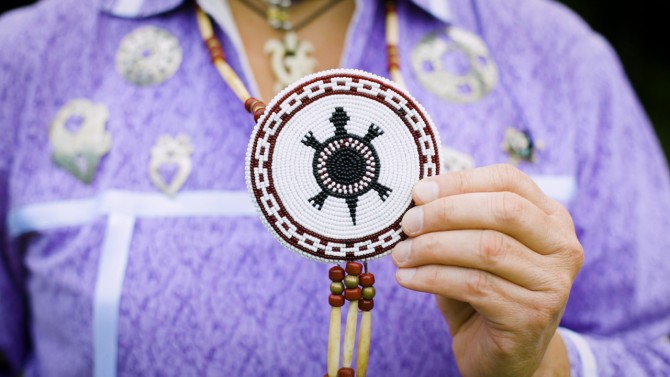Perry Ground ’91 travels around the world performing traditional stories of the Haudenosaunee, sometimes called the Iroquois Confederacy. He adapts the stories to the present while keeping their traditional spirit intact.
A storyteller makes ancient Native American tales new again
By Susan Kelley
Perry Ground ’91 couldn’t find a seat in Rural Sociology 175.
So he sat on the floor, like he did as a kid when his great-grandfather and grandmother told Native American stories around the woodstove or a picnic table at home.
What he experienced in that class, late in the spring semester of his freshman year, would help him explore his Native American identity – and share that cultural heritage too.
Teaching Assistant Steve Fadden ’88, MPS ’93, a Mohawk storyteller from a family of storytellers, began telling Native American tales and explaining the traditions, beliefs and values embedded in them.
“I saw the reaction from all the students: They were captivated by it,” Ground says. “I said, this is it. This is a way to teach in a positive way, to draw people in so that they are included and want to learn more. I realized, in that moment, how powerful these stories could be.”
Ground now travels around the world performing traditional stories of the Haudenosaunee (sometimes called Iroquois) Confederacy, adapting them to the present while keeping their ancient spirit alive.
He’s performed in schools throughout New York state, at the National Museum of the American Indian in Washington, D.C., and in Belgium, Croatia and Serbia. For the 2021-22 academic year, he is the Frederick H. Minett Professor at Rochester Institute of Technology.
“A lot of what I’m doing is taking these old written versions from the late 1800s, early 1900s, with Victorian-style language, and bringing them into a modern setting that is accessible and understandable,” Ground says. “The most important thing to me is that the audience goes away happy, and that they have a positive impression of Native Americans.”
“I would call him a new traditionalist,” says Joseph Bruchac ’64, a Nulhegan Abenaki author and storyteller in Greenfield Center, New York, who has known Ground for three decades. “He brings the relationship of the modern world to the past. He can really read an audience and understand that he’s getting across to them in a way that not many storytellers can. He’s really quite gifted that way.”
Adapting and evolving
Ground grew up in Niagara Falls, New York, only occasionally visiting his father’s Tonawanda Seneca reservation and the Onondaga Reservation where his mother was born. After his parents divorced, his mother married a man of Italian descent. “I feel like I grew up in a very Italian household, as opposed to a Native American household,” he says.
He and his sister were the only Native American kids at their school. Like many young people, he struggled to define his identity.
That changed at Cornell.
As a freshman, Ground participated in Cornell’s American Indian and Indigenous Studies Program, through which students study and contribute to the building of Indigenous nations and communities. Surrounded by other Native American students, he began to explore his identity as a Turtle Clan member of the Onondaga Nation of the Haudenosaunee (pronounced Ho-di-no-SO-ni) Confederacy of six sovereign nations.
“It was new, it was exciting. It was instructive for me, as a Native person,” Ground says. “Being able to take classes to learn more about Native American history and culture, I was also learning about myself and who I was.”
After his freshman year, he worked for the summer as a park aide at Ganondagan, a state park dedicated to Seneca culture in Victor, New York, where he began to tell stories with Marion Miller, a Seneca storyteller. “By the end of that summer, I knew I wanted to find a way to use the stories to educate people positively about Native Americans,” he says.
Now Ground always starts his stories in the same way. He claps his hands once and says, “This story happened a long time ago, back when the Great Turtle Island was new.”
The Haudenosaunee traditionally told these tales only in the winter, around fires in longhouses that sheltered 60 to 80 people. They mix the mythic with the everyday. Monstrous flying heads zoom through the forest, representing Nature’s destructive forces – and humans’ negative traits. Bear Woman shape-shifts into human form and adopts a young boy lost in the forest, teaching him how to recognize a focused hunter. Magical corn replicates to feed an entire village, while tricksters like Fox get their comeuppance. When Sky Woman falls from a hole in the sky, Turtle offers her his back as a place to live and build the Earth, also known as the Great Turtle Island.
Creation stories describe how rain came to be and why a species of tree grows a certain way. Historical stories teach about specific events, like the six nations forming the confederacy. Some stories teach the proper way to behave. Others simply entertain, Ground says. “They’re supposed to be fun.”
A lacrosse player, Ground acts out the story’s plot. Sometimes he leaps into the audience. “I flip somebody’s hat around, or I pull a hood over their head, or I tug on their leg or play with their hair,” he says. “I’ll say ‘Hey, you’ve got to be careful when you’re around Fox. He’s a pretty tricky kind of guy.’
“It’s a way to bring things into the present,” he says. “The more action, activity and movement I add to it, the less static it is.”
He’ll pause to explain concepts or words that his audience might not know – like marriage bread. Traditionally women offered men this corn bread made of boiled white corn to propose marriage. “I try to think about, how did Native people hear a story 500 years ago, before Europeans?” Ground says. “How does this story need to be presented now, with enough information that people will understand it?”
During COVID-19 lockdowns, he pivoted to virtual performances. Through the University of Iowa, he performed stories for Native Americans tuning in from Native health centers throughout the U.S. and Canada.
And he began serializing his stories on Facebook, each installment accompanied by illustrations, often by Native American artists. He has some 11,000 followers, the majority Native Americans. Students at the Akwesasne Freedom School in Hogansburg, New York, where they learn exclusively in Mohawk, translate the stories into Mohawk and recite them as part of their daily lessons.
“In our traditions, stories are used to entertain and to teach,” Bruchac says. “If they are entertaining, they’ll be remembered. More than anything else, Perry wants these stories to actually play their original role, which is teaching and guiding, especially the new generation of younger people.”
New genres, ancient roots
Ground also wants his audiences to understand Native Americans are human beings, adapting and changing as all cultures do over time. “So many times, people think Native Americans today are storybook characters come to life – that we have stepped off the pages of ‘I Is for Indian,’” he says. “I want people to go away with a positive impression of Native Americans – but also that this is a group of human beings who has existed here in North America for thousands of years, and these stories are contemporary stories for everyone.”
He’s currently writing a movie script, a fantasy action film about the peacemaker who brought together the Haudenosaunee Confederacy, similar in spirit to the Marvel film “Black Panther.”
And he’s writing scripts for a fantasy action television series. The main character, a Haudenosaunee man, is immersed in the stories in the time when the Great Turtle Island was new. Meanwhile, a heroine lives the same stories in the present day. It’s a bit of a love story too, Ground says.
“We’re really trying to create a new genre,” he says. “But the message, or the lesson within the story – that part remains the same.”
Media Contact
Get Cornell news delivered right to your inbox.
Subscribe



